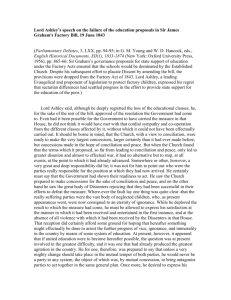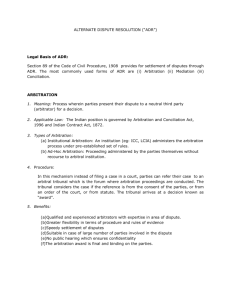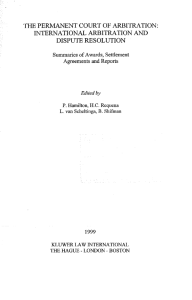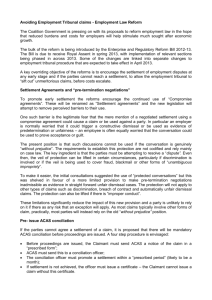Information on the system of conciliation of labour disputes by the
advertisement
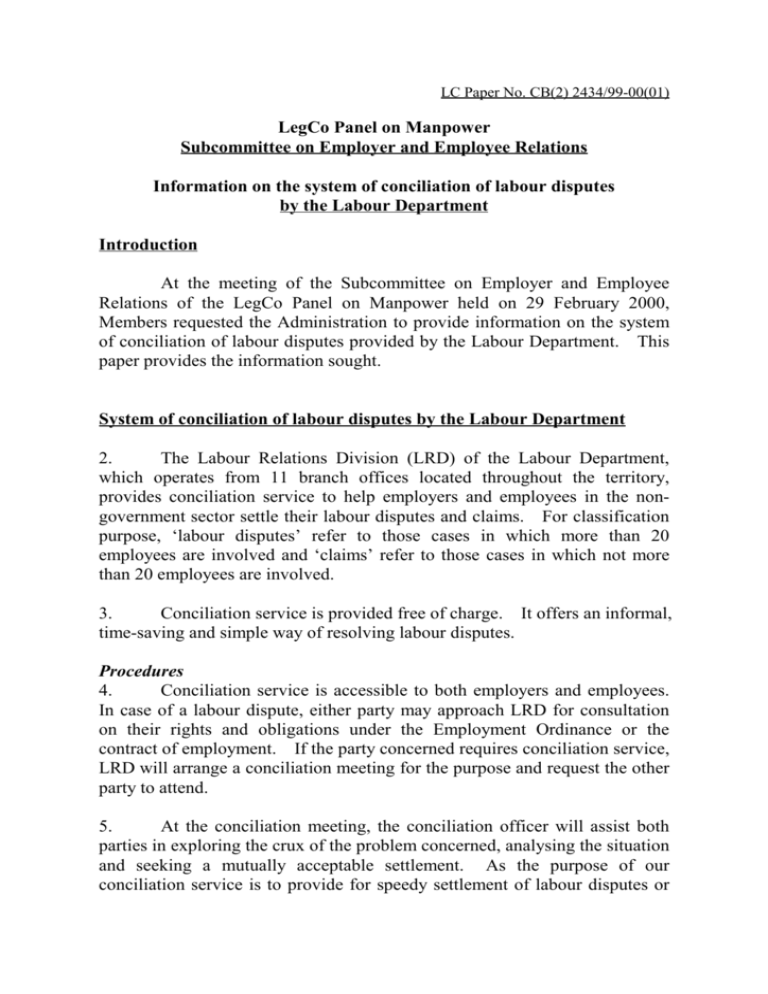
LC Paper No. CB(2) 2434/99-00(01) LegCo Panel on Manpower Subcommittee on Employer and Employee Relations Information on the system of conciliation of labour disputes by the Labour Department Introduction At the meeting of the Subcommittee on Employer and Employee Relations of the LegCo Panel on Manpower held on 29 February 2000, Members requested the Administration to provide information on the system of conciliation of labour disputes provided by the Labour Department. This paper provides the information sought. System of conciliation of labour disputes by the Labour Department 2. The Labour Relations Division (LRD) of the Labour Department, which operates from 11 branch offices located throughout the territory, provides conciliation service to help employers and employees in the nongovernment sector settle their labour disputes and claims. For classification purpose, ‘labour disputes’ refer to those cases in which more than 20 employees are involved and ‘claims’ refer to those cases in which not more than 20 employees are involved. 3. Conciliation service is provided free of charge. It offers an informal, time-saving and simple way of resolving labour disputes. Procedures 4. Conciliation service is accessible to both employers and employees. In case of a labour dispute, either party may approach LRD for consultation on their rights and obligations under the Employment Ordinance or the contract of employment. If the party concerned requires conciliation service, LRD will arrange a conciliation meeting for the purpose and request the other party to attend. 5. At the conciliation meeting, the conciliation officer will assist both parties in exploring the crux of the problem concerned, analysing the situation and seeking a mutually acceptable settlement. As the purpose of our conciliation service is to provide for speedy settlement of labour disputes or claims, no legal representation for both parties is required or encouraged. However, if one party finds the company of a third party (e.g. a trade union representative) necessary when attending the conciliation meeting, it is acceptable subject to the agreement of the other party. To ensure the trust of the parties concerned which is important for settlement, the conciliation meeting is held in confidence and both parties are free to make admissions during the meeting for settlement purpose. 6. If the case can be settled by conciliation and the settlement involves compensation by cash payment, the conciliation officer will make arrangements for effecting payment. Where necessary, the conciliation officer will also assist in drawing up a settlement memorandum for signature by the parties. On the other hand, if one party declines to make use of our conciliation service or both parties have failed to reach a settlement at the end of the conciliation meeting, the conciliation officer will, at the request of the party concerned, refer him to seek adjudication at the Minor Employment Claims Adjudication Board (for cases involving not more than 10 claimants and not exceeding $8,000 per claimant) or the Labour Tribunal (for cases involving more than 10 claimants or exceeding $8,000 per claimant). In cases of insolvencies, the employees concerned will be referred to the Legal Aid Department for assistance in filing a winding-up petition and also to the Protection of Wages on Insolvency Fund to apply for ex-gratia payment. 7. Attendance at conciliation meetings is voluntary for both parties. This is because a settlement reached by conciliation is a result of compromise and mutual understanding between the two parties. The willingness of both parties to make use of the conciliation service is the major factor for successful settlement of the labour dispute or claim. Role of conciliation officers 8. The conciliation officer is a neutral and impartial intermediary. He assists both parties to understand the problem and to have a frank dialogue so as to remove each other's differences and prevent the dispute situation from further deterioration. He also endeavours to seek a settlement which is acceptable to both parties. 9. The conciliation officer does not have adjudication power to impose settlement in disputes or claims. Whether or not to settle a case through conciliation is a free decision of the parties concerned. However, in the event that a breach of the Employment Ordinance is detected, it will be investigated thoroughly with a view to prosecution against the suspected offenders. 2 3 Labour Relations Ordinance 10. The Labour Department operates under the Labour Relations Ordinance (LRO) to conciliate in labour disputes in the non-government sector. The LRO provides for improvement of labour-management relations and sets out procedures for the settlement of disputes. The Ordinance enables the Commissioner for Labour to inquire into and authorise a conciliation officer to conciliate in a dispute between employer and employees. It also provides for the procedures of dispute settlement, namely special conciliation, mediation, arbitration, board of inquiry and cooling-off period, to be invoked when necessary. 11. The existing procedures have worked well in resolving labour disputes in Hong Kong. The bulk of disputes could be settled through conciliation. Except for special conciliation which was invoked twice in the past, the dispute settlement procedures provided in the LRO have never been invoked as it was not necessary to do so. Performance of the conciliation service of the Labour Department 12. Since the economic downturn in late 1997, the number of claims and disputes handled by LRD has increased substantially. In 1999, LRD handled a total of 32 180 cases, including 290 labour disputes and 31 890 claims. This represented an increase of 56.5% over 1997 (20565 cases) and 5.2% over 1998 (30541 cases). 13. It has also become more difficult to resolve labour disputes and claims through conciliation in the past two years. This is attributable to two reasons. First, owing to the tough business environment since late 1997, many employers have experienced financial difficulties and become more cost conscious. They are often less prepared to make concessions during the conciliation proceedings. This has to some extent adversely affected the settlement rate. Secondly, the enactment of the employment protection provisions of the Employment Ordinance in June 1997 has given rise to claims for remedies for unreasonable or unlawful dismissals, which are often difficult to settle. It is because the claims often involve complicated legal arguments and consideration. As employers may be liable to pay the dismissed employees a large amount of compensation (at a maximum of $150,000) for claims of unreasonable and unlawful dismissal, the parties in dispute are also less willing to settle the matter through conciliation. They would wish to seek adjudication by the Court instead. Hence, the success rate of conciliation is generally lower for this type of claims. 4 14. Despite the above difficulties, LRD managed to settle more than 60% of the total number of labour disputes and claims handled in the past three years. 15. The mechanism for settlement of labour disputes and claims through voluntary conciliation has proved to be effective in ensuring harmonious employer-employee relations. The generally peaceful labour relations scene is reflected by the small number of working days lost due to industrial conflicts. In the past three years (1997 to 1999), the average number of working days lost due to strikes per 1 000 wage earners and salaried employees was only 0.28 working day. This is among the lowest in the world. Conclusion 16. In general, employers and employees are willing to make use of our conciliation service to settle their dispute. This can be seen from the fact that, amongst the 31 890 claims handled by the Labour Department in 1999, there are only 862 claims (or 2.7%) in which the claimants had to pursue their claims through legal proceedings at Court because the other party had refused to take part in conciliation. The existing system of conciliation is longestablished and well-tested. It provides an effective framework for settlement of labour disputes which, together with other services provided by the Labour Department to promote good industrial relations, has served Hong Kong well under our free market economy. Labour Department June 2000 5
